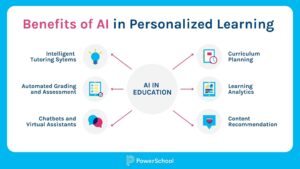Predictive Technologies and AI in Education
AI has been an emerging tool for many industries, one of which is education. For example, Grammarly. Grammarly uses AI to provide grammar, punctuation, and style suggestions (Ravaglia, 2023). The impact of grammarly is very evident. Grammarly used to just catch spelling and grammar mistakes, but through the years it’s become more like a full-on writing assistant (Ravaglia, 2023). Today, it also helps with things like tone, clarity, and making writing more effective (Ravaglia, 2023). Some teachers might worry that with all of Grammarly’s features and capabilities, students will rely too much on it and avoid doing their own work. While students may find ways to get out of doing homework, Grammarly has built-in safeguards to prevent that from happening (Ravaglia, 2023).
Benefits of AI in Education

According to Chen et al. (2020), research on AI in education shows that AI can enhance learning and teaching by offering personalized learning, automating tasks, and creating adaptive learning environments.
Personalized learning
AI tools, like virtual patient training or smart virtual labs, adjust tasks based on how well students are doing. They change the difficulty in real-time to match the student’s skill level. This helps students focus on the right content for them. Personalized learning ensures students get the support they need, making learning more efficient and helping them stay on track.
Automation of task
Exams and assignments can be graded swiftly, precisely, and securely by AI tools like automatic grading. This provides students with immediate feedback. Furthermore, automation saves teachers time by handling menial tasks, which allows for quicker feedback and more time for teachers to focus on teaching and improving their skills.
Challenges of AI in Education
Advancements come with several challenges. Resistance to change is a major challenge when it comes to using AI in education. Teachers and students may be uncertain of adopting AI tools like ChatGPT due its unfamiliarity with how they work and its benefits. Educators may overcome this resistance, if they utilize AI to promote collaboration, instead of just allowing students to copy and paste information.
In this youtube video, they discussed how Chatgpt is being used in education. For instance, one panelist mentions a teacher in Sydney who encouraged students to use ChatGPT not just as a shortcut for answers, but as a learning partner in the process. In this example, the student submits the conversation and the teacher grades the students’ way of asking the bot questions. By encouraging students to think more critically and imaginatively, this approach shows how AI may elevate assignments.
Ethical Considerations of AI in Education
AI in education raises ethical concerns around data privacy, transparency, and bias. To combat these issues, educators should select tools with strong safety measures and limit data collection in order to protect student privacy (Shah, 2023). AI can perpetuate bias if trained on unrepresentative data, so educators should prioritize tools that are tested for fairness (Shah, 2023).
Future Directions in EdTech
In the next 5-10 years, Virtual Reality (VR) and Augmented Reality (AR) will change how students learn by creating interactive and immersive experiences. Using VR allows students to explore complex ideas in 3D. In the near future, educators will shift from the traditional lectures to guiding students through hands-on, interactive learning. Instead of explaining things like historical events, educators will take students on virtual field trips where they can explore these topics in 3D. For example, tools like Google Expeditions, teachers can take students on virtual trips to places they couldn’t visit in real life, making learning more exciting and engaging.
References
Chen, L., Chen, P., & Lin, Z. (2018). Artificial Intelligence in Education: A Review. IEEE Explore, 8, 75264–75278. https://ieeexplore.ieee.org/abstract/document/9069875
Ravaglia, R. (2023, October 5). Generative AI makes grammarly an essential student learning tool. Forbes. https://www.forbes.com/sites/rayravaglia/2023/08/28/generative-ai-makes-grammarly-an-essential-student-learning-tool/
Shah, P. (2023). Ethical Considerations for AI in Education. In AI and the Future of Education. John Wiley & Sons, Incorporated.